Federal Palace of Switzerland
The Federal Palace (German: Bundeshaus, French: Palais fédéral, Italian: Palazzo federale, Romansh: Chasa federala, Latin: Curia Confœderationis Helveticæ) refers to the building in Bern housing the Swiss Federal Assembly (legislature) and the Federal Council (executive). It has a total length of more than 300 metres (980 ft) consisting of a central assembly building and two wings (eastern and western) housing government departments and a library. The name in German and Romansh both mean "federal house", whereas the French and Italian names both translate to "Federal Palace". The Latin word curia originates from Ancient Rome and originally meant an assembly, and later used for where the Roman Senate met, both meanings being relevant to the Federal Palace.
| Federal Palace | |
|---|---|
(in German) Bundeshaus (in French) Palais fédéral (in Italian) Palazzo federale (in Romansh) Chasa federala (in Latin) Curia Confœderationis Helveticæ | |
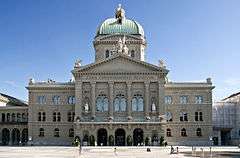 View from the Bundesplatz | |
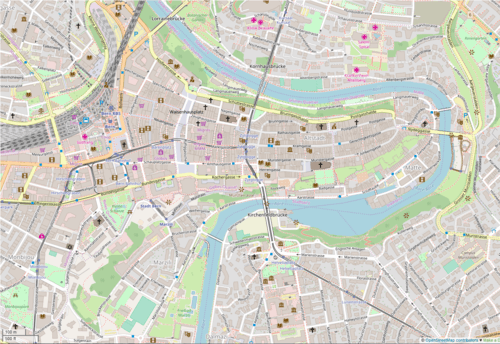 Federal Palace Location within Bern  Federal Palace Federal Palace (Canton of Bern)  Federal Palace Federal Palace (Switzerland) | |
| General information | |
| Address | Bundesplatz 3 CH-3005 Bern |
| Town or city | Bern |
| Country | Switzerland |
| Completed | 1 April 1902 |
| Design and construction | |
| Architect | Hans Wilhelm Auer |
History
The building was designed by the architect Hans Wilhelm Auer and constructed between 1894 and 1902 by 173 Swiss firms and 33 Swiss artists.[1] Its inauguration took place on 1 April 1902. The total cost, at the time, was 7,198,000 Swiss Francs.
Domed Hall
The central assembly building is dominated by a domed hall in the layout of a Swiss cross.[1] It separates the two chambers of the National Council (south) and the Council of States (north). The dome itself has an external height of 64 metres (210 ft) that was exceptional at the time, but chosen to balance the total length of the three buildings. [2] The mosaic in the center represents the federal coat of arms along with the Latin motto Unus pro omnibus, omnes pro uno (One for all, and all for one), surrounded by the coat of arms of the 22 cantons that existed in 1902. The coat of arms of the Canton of Jura, created in 1979, was later placed outside of the mosaic. The hall is dominated by the sculpture The Three Confederates (Die drei Eidgenossen) created by James André Vibert and referring to the legendary oath to fight for Switzerland (Rütlischwur).
North Façade
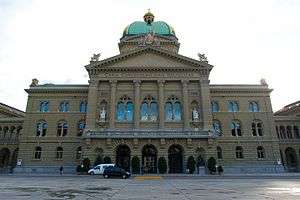
The central entry facing the Federal Square (Bundesplatz) and opening up to a domed hall carries the inscription Curia Confœderationis Helveticæ (Swiss Federal Assembly) underneath a pediment. The roof edge is topped by Auguste de Niederhäusern-Rodo's allegorical sculpture of Helvetia representing independence (center), with the executive on her left, and the legislature on her right. This arrangement was inspired by the Pallas Athena Fountain of the Austrian Parliament.[2] The pediment is flanked by two griffins by Anselmo Laurenti symbolizing courage, wisdom, and strength. The female allegories in the second floor niches by James André Vibert represent freedom (left) and peace (right).[1] Two commemorative plaques above refer to the years 1291 (Federal Charter and the legendary Rütlischwur) and 1848 (first Federal Constitution transforms Switzerland into a federal state). Finally, the male allegories in the first floor niches by Maurice Reymond represent the chronicler of the past (left) and the chronicler of the present (right).[2]
Organisation
- Federal Assembly
- Hall of the dome
- Visitor centre[3]
- West wing
- Federal Council[4]
- Federal Chancellery of Switzerland
- Federal Department of Foreign Affairs
- Federal Department of Justice and Police
- Carl Lutz Room.[5]
- East wing
- Federal Department of Economic Affairs, Education and Research
- Federal Department of Defence, Civil Protection and Sports
Trivia
As reported in a study by the Federal parliamentary services (Parlamentsdienste), the noise caused by human activities in the chamber of the National Council is clearly too loud. The previously undisclosed study was published by 10vor10 on 12 December 2014, pointing that the noise level is usually at a level of about 70 decibels, comparable to a used roadway, so concentration of work for politicians is not possible.[6]
Gallery
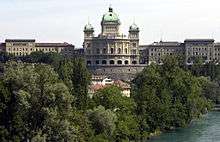 Federal Palace from the South, with the West and East wings
Federal Palace from the South, with the West and East wings The south side of the Federal Palace, with the river Aare in the foreground
The south side of the Federal Palace, with the river Aare in the foreground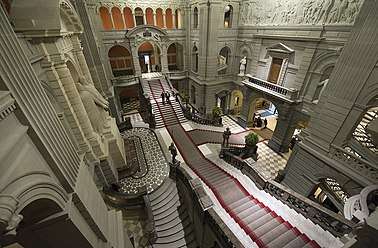 The central domed hall
The central domed hall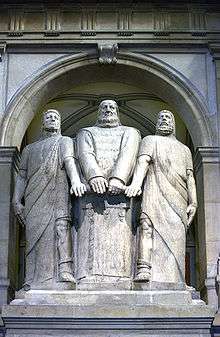 The Three Confederates
The Three Confederates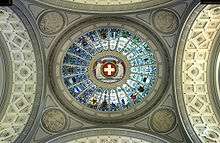 Dome of the Federal Palace. The name Jura can be read at the bottom of the picture, indicating where the coat of arms of the Canton of Jura was placed after the secession from Berne in 1979
Dome of the Federal Palace. The name Jura can be read at the bottom of the picture, indicating where the coat of arms of the Canton of Jura was placed after the secession from Berne in 1979 The salle des pas perdus
The salle des pas perdus The chamber of the National Council (and of the United Federal Assembly)
The chamber of the National Council (and of the United Federal Assembly) The Council of States chamber
The Council of States chamber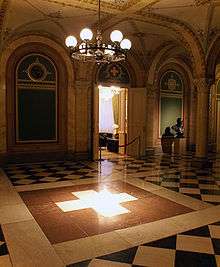 Inside the west wing of the building
Inside the west wing of the building A meeting room for political parties
A meeting room for political parties Full flags during state visit
Full flags during state visit Pediment with inscription and allegorical sculpture
Pediment with inscription and allegorical sculpture
See also
- Bundesplatz
- Hotel Bellevue Palace
References
- Federal Chancellery of Switzerland (2017). The Parliament Building in Bern, Switzerland (PDF) (12/2017 ed.). Federal Chancellery of Switzerland. pp. 5–18.
- Stückelberger, Johannes (1985). "Die künstlerische Ausstattung des Bundeshauses in Bern" [The Artistic Design of the Federal Palace in Bern] (pdf). Zeitschrift für Schweizerische Archäologie und Kunstgeschichte (in German). 42 (3): 185–234. doi:10.5169/seals-168629.
- Visiting the Parliament Building, Federal Assembly (page visited on 11 September 2016).
- (in French) "Dans les appartements des sept sages", Le temps, Sunday 12 May 2013 (page visited on 11 September 2016).
- "'Swiss Schindler' honoured with room in Federal Palace". The Local. Retrieved 15 February 2018.
- "Lärmbelastung im Nationalrat deutlich zu hoch" (in German). 10vor10. 12 December 2014. Retrieved 13 December 2014.
External links
| Wikimedia Commons has media related to Bundeshaus Bern (Federal Palace of Switzerland). |
- Official website
- Federal Palace in German, French and Italian in the online Historical Dictionary of Switzerland.